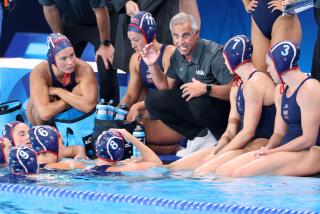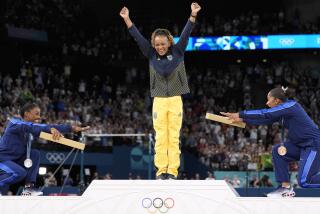An Olympic Dream Still Burns : Quance Tries to Shake Off Her Disappointment With New Goals
Reminders are everywhere. The GAP ad featuring Anita Nall. Headlines in newspapers. Magazine cover stories and a seemingly endless barrage of television programming.
Some of her classmates at Granada Hills High didn’t know. They meant well, but each time they asked: “When are you leaving for Barcelona?” Kristine Quance was reminded again.
Other classmates and friends, aware of her disappointment, did not broach the subject. “They don’t say anything,” Quance said, “because they are afraid I’ll start crying.”
Long before the Olympic flame was ignited by an archer’s arrow, David Bourne, Quance’s boyfriend, urged her not to watch the Games.
“Every time (an Olympic) commercial would come on, a smile would fade from her face,” said Bourne, a standout catcher at Kennedy High.
Perhaps Quance, 17, should have sought refuge at a Club Med. No TV, no newspapers, no radio . . . no Olympics.
But she could not resist watching what an ill-timed case of mononucleosis caused her to miss.
She tunes into the Triplecast and NBC’s Olympic coverage from her Northridge home between twice-daily training sessions with the Calabasas-based CLASS Aquatics team.
The second-fastest American 200-meter breaststroker in history, Quance finished a gutsy third in her weakened state in the U. S. Olympic trials, one place shy of an Olympic berth.
“It was kinda funny watching the 200 breaststroke,” Quance said. “Before it started, I was getting kinda nervous. The way I feel before I swim.”
In the opening 100, Quance feared for Nall, the world record-holder from Towson, Md.
“She had tired in the morning (preliminaries) and I was afraid she went out too fast,” Quance said. “Then, when they started catching her, I said, ‘Oh, my gosh, I can’t watch.’ ”
Nall wound up with a bronze medal, after falling behind Japanese teen-ager Kyoko Iwasaki and China’s Lin Li.
Quance also had mixed emotions watching the 400 individual medley because she was expected to earn a berth on the U.S. team in that event after her silver-medal winning performance behind American Summer Sanders in the Pan Pacific championships last August in Edmonton, Canada.
Sanders earned a bronze medal Sunday and broke Janet Evans’ American record, but the other American entrant, Erika Hansen, did not make the finals after swimming 7.1 seconds slower than her trials’ effort.
“It’s my second-best event so it was kinda hard to watch, especially when Erika didn’t make the finals,” Quance said. “It was kinda weird watching it. It’s hard to explain. I wish I could be there.”
Quance has made that wish since she was a child. Even after her condition was diagnosed as mononucleosis in February, she held out hope for a miracle at the Olympic trials.
“I felt it was a bad dream,” Quance said.
While sleeping 18 hours a day, Quance replaced the nightmare with a hopeful dream, one in which time stood still. For the 2 minutes 27 seconds she would need to make the Olympic team, her fatigue would subside.
But it was only a dream.
Win or lose, David and Sandy Quance, Kristine’s parents, wanted to surprise their daughter with a party the day she returned from the trials in Indianapolis.
Friends, relatives, former coaches and teammates filled the Quance home. All played a part in Kristine’s success. The show of support was extraordinary. Kristine and most of her 100 guests were overcome by emotion.
“We didn’t know if it was the right thing to do,” Sandy said, “but it worked out for the best. She got to face everyone at one time.”
The party eased her pain, but Quance admits: “I was a mess for about a month and a half, and then I finally realized that I can’t do anything about it. I have to control what I can control and train for the next four years.”
As Quance spoke at her home, Evans, a world record-holder, appeared on the TV screen. For the TV cameras, Evans put up a brave front after her silver-medal finish in the 400 freestyle.
It has not been easy for Quance to see so many Americans fall short of their expectations.
“It tells me that in the next four years, I have to be so much better than the competition that I can overcome them even on a bad day,” she said. “Because it’s kinda scary, Jenny Thompson and Janet Evans and even Matt Biondi . . . to see them getting beat when they totally expected to win.”
As she removed an ice pack from her shoulder, Quance acknowledged what every swim coach in America could predict: She is having a great week of practice during the Olympic Games.
“I don’t know if it is the Olympics,” Quance said. “But they have made me want to go hard and put up faster times at nationals (Aug. 17-21 at Mission Viejo). I know it’ll be hard to do because I’ve missed so much practice getting over the mono, but I still want to set goals and if I don’t get them, there is always next year.”
Quance prefers to view the lengthy preparation for the ’96 Games in Atlanta on a meet-by-meet basis: the Pan Pacific championships next summer, the Goodwill Games and the world championships in ’94 and the Pan Pacific meet in ’95.
Plus, she will have collegiate swimming, beginning in the fall of 1993, to help maintain her interest.
Then, the Olympic blitz will begin again.
The rings, the torch bearers, the flame . . . Kristine Quance can only hope that next time these symbols won’t make her wonder what might have been.
More to Read
Go beyond the scoreboard
Get the latest on L.A.'s teams in the daily Sports Report newsletter.
You may occasionally receive promotional content from the Los Angeles Times.






